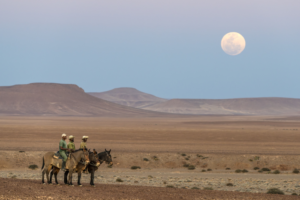Mules can sometimes be famously stubborn, but they are also sure-footed and reliable. Establishing a Mounted Patrol Unit (MPU) with mules at Save the Rhino Trust (SRT) in Namibia has been a challenging but important activity. Adept at travelling long distances, and more resistant than horses to zebra-borne disease, mules can trek deep into remote areas, helping to increase the Trust’s presence and monitoring capacity throughout the 25,000km2 landscape in which they operate.
The introduction of this unit comes at an important and opportune time. By mid-2023, the cost of petrol in Namibia was at its highest in living memory, 50% higher than the cost in January 2021. Severe droughts have caused wildlife populations – including rhinos – to disperse further afield in search of water, whilst disturbances from the opening of new mines have pushed rhinos out of former ranges. Add to this the rising costs of food, equipment and construction materials, and monitoring Kunene’s rhinos becomes increasingly difficult.
Having a form of transport that can be deployed quickly to seek out rhinos in areas inaccessible by vehicle is now more vital than ever. But establishing a base camp for the Unit in one of the remotest places on Earth has not been easy: there has been both progress and setbacks along the way.
The priority was water supply for the camp. Despite being close to a permanent natural spring, the first attempt to drill a borehole yielded an insufficient flow of water. The second, going down to 70m, hit the jackpot and a solar panel and water pump were installed. Protection was also built to shield the new water point from the desert’s highly intelligent and mischievously destructive desert elephants.
Another issue was protection of the mules themselves from desert lions. Persecuted by farmers to the brink of extinction by the 1980s, this small population of highly adaptable lions has learned to cover great distances and focus on more unusual prey, from seals on shorelines to sheep in stockades. Measures have been implemented to keep the mules safe, but unfortunately, in the early days of the project, a lion managed to get in, killing one of the mules and injuring another whilst they were in temporary stables.
At the new camp, motion-sensitive floodlights have now been installed, alongside a physical fence to keep the mules in and deter predation (acknowledging that complete prevention of predation is almost impossible). However, perhaps the greatest innovation has been the implementation of a ‘geo-fence’. As the desert lions travel incredible distances in search of food, and conflict with livestock farmers is a constant concern, many prides have had at least one individual fitted with a GPS collar, allowing rangers to monitor their whereabouts. This tracking system has enabled SRT, in collaboration with a partner NGO, to set up a 5km perimeter around the camp. If a collared lion crosses this invisible boundary, a warning message is sent to the team. This came in handy in March 2023, when lions entered the perimeter, setting off warning signals. SRT’s trackers, pre-warned, were able to scare away the lions.
Minimising interaction with lions is an ongoing challenge for the team, but funds have been raised to construct new, solid stables at the camp, which are expected to be complete by the end of 2023. These, in combination with the lights, geo-fence and physical fencing should be enough to keep marauding predators at bay.
Despite these setbacks, by August 2023 the MPU had covered almost 300 km during operational months. For the rest of the year, the Unit intends to carry out full monthly patrols, searching for missing rhinos that could be hidden deep in the wilderness. There has already been success: recent mining activity in the landscape disturbed resident black rhinos, causing them to disperse widely. The MPU was able to track and log sightings of every rhino known to have been displaced and – on this occasion – all were found to be in good health.
With mounting demand for valuable metals such as tin, copper and even lithium for renewable energy, SRT is already working with other key players in the Kunene Region to voice its concerns on mining in the area. Unfortunately, it is likely that more rhinos will be displaced by such human activities in the future; the MPU will play a crucial role in locating and monitoring them.
Thanks to your generous support, Save the Rhino has been able to provide funding to help cover the salaries of the MPU team, as well as veterinary care, food (for both rangers and mules), camp construction costs, water pump installation, and rhino-sighting bonuses.
While the rest of Namibia saw a disturbing rise in the number of rhinos poached during 2022 (from 45 in 2021 to 87 in 2022), the rhino population of Northwest Namibia has remained stable, with no poaching detected since 2020. Tough times lie ahead but, with new babies sighted, this precious population may even be growing. The presence of teams, including the MPU, on the landscape is one important factor keeping these rhinos safe.















